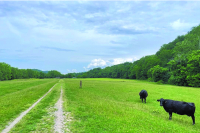Blow the tannery whistle: Bradbury still burns, 72 years later
I first read “Fahrenheit 451” around 1953 when we were dealing with the McCarthy era. This country was in the grips of a politician who preached a dangerous message. He said that America was being invaded by communism and he urged everyone to assist him in seeking out and removing anyone who had joined this dangerous movement.
The brief history of the Sylva Collegiate Institute
Back in the 1940s, while World War II was still raging in Europe and the Philippines, Charlie Kilpatrick and I used to entertain ourselves by prowling through the kudzu thickets near his house.
‘Paradise will be some kind of library’: Carden cements legacy with historic library donation
Gary Carden has accomplished a great deal in his life. But by his own estimation, none of it compares to his most recent endeavor — donating a treasure trove of books to the Jackson County Public Library that took him a lifetime to collect.
Rain on the scarecrows (concluded)
Several weeks ago, I published an article that dealt with a trip to Tellico Plains with the Principal Chief of the Cherokees, John Crowe. This was back in 1976 and the Tennessee Valley Authority had announced their plans to flood the Tellico Plains.
Blow the tannery whistle: Scarecrows in the rain
This one is for my old friends, living and dead, in Cherokee. Here’s to you, Trigger Young, Woody Sneed, Bill Young, Darlene Whitetree, Homer Burgess, Wanda Lee Burgess, Darlene Bradley, Ralph Henry, Jean Holt, Ethelene Conseen, Johnson Catoaster, Johnson Lee Owle, Eddie Swimmer Wilber Paul and a hundred others.
Blow the tannery whistle: Foxfire Christmas: traditions and superstitions
Back in the 1980s, when I was telling stories in the Cope Crest Conference Center in Tiger, Georgia, I heard about Eliott Wigginton, who was teaching English in the Rayburn County school system.
Blow the tannery whistle: A tale of two Abrahams
I remember a day in March when I was in the seventh grade. We were on the second floor of the old Sylva Elementary building, and we had a kind of ritual that involved the pencil sharpener.
‘An Imaginative Proclivity’: Gary Carden and “Stories I Lived to Tell”
In “Stories I Lived to Tell: An Appalachian Memoir” (The University of North Carolina Press, 2024, 152 pages), 89-year-old storyteller and writer Gary Carden spends much of his time revisiting his youth and childhood.
Of parched corn and rank strangers: Ahead of new book, Gary Carden reflects on a lifetime of storytelling
So I walk into Gary Carden’s room in the ICU and the first thing he says to me in his sonorous growl is, “OK newspaperman, take this down. I want you to turn this into a story.”
Discounted preorder for Gary Carden’s memoir now available
Legendary Western North Carolina storyteller Gary Carden is at it again, this time, with a new memoir due out from UNC press later this year.













